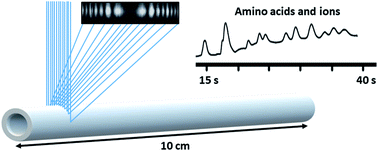Direct detection of inorganic ions and underivatized amino acids in seconds using high-speed capillary electrophoresis coupled with back-scatter interferometry
Abstract
High speed capillary electrophoresis (HSCE) combined with refractive index (RI) detection is developed for the rapid separation and detection of inorganic ions and amino acids. A mixture of three inorganic ions (K+, Na+, Li+) and eight amino acids (Lys, Arg, Ala, Gly, Val, Thr, Trp, Asp) are detected using back scatter interferometry (BSI), without the need for chemical modifications or contrast. A thin-walled separation capillary (50 μm i.d. by 80 μm o.d.) helps mitigate Joule heating at the high field strengths required for rapid separations. This, combined with a short 8 cm length-to-detector (10 cm total length), enables separations on the seconds time scale. Using a background electrolyte (BGE) of 4 M acetic acid (pH 1.6) and a field strength of 900 V cm−1, all 11 analytes are separated in less than 40 s. Moreover, peaks in the BSI signal arising from the sample injection and EOF, enable electrophoretic mobilities to readily be obtained from apparent mobilities. This leads to excellent repeatability, with analyte electrophoretic mobilities varying from 0.39 to 1.56 % RSD over eight consecutive separations. The universal detection of inorganic ions and amino acids without prior chemical modification or additives in the BGE is an advantage of refractive index detection. A disadvantage arises from modest detection limits. Here, however, we show that submicromolar detection is possible with careful thermostatting of the thin separation capillary. A series of electropherograms are used to quantify arginine concentrations from 700 nM to 500 μM, using 50 μM Li+ as an internal standard. The resulting calibration curve leads to a calculated LOD of 376 nM and a LOQ of 1.76 μM. Diagnostically relevant amino acid panels are also separated, illustrating the potential for future applications in neurodegenerative and metabolic disease diagnostics. HSCE combined with BSI detection, therefore, is shown to be a rapid, sensitive, and universal approach for analyzing sample mixtures.



 Please wait while we load your content...
Please wait while we load your content...